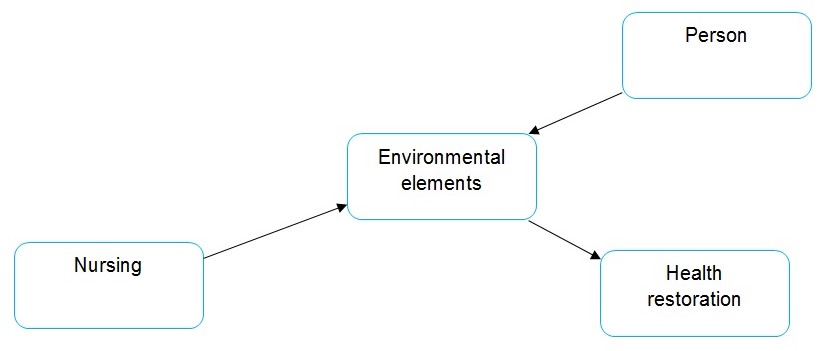Introduction
Nursing practice in the modern day has evolved from the known way of practice several decades ago. What was treated at that time as a simple work for women has now evolved into a twofold component involving both theory, practice, men and women. When compared to a building, nursing theory serves as the foundation, while practice serves as the finishing touches that actually make the functioning of the building possible. Thus, this analytical treatise attempts to explicitly review the tenants of the Florence Nightingale’s theory and her views on nursing education. Besides, the treatise reflects on society’s view of nursing during her era and describes the relevance of her theory at present.
Tenants of Florence Nightingale’s theory
Often referred to as the “Lady with the Lamp”, Florence Nightingale is founder of nursing science and educated nurses practice. As a nursing theorist, Florence conceptualized environmental theory. This theory incorporates health status restoration of the client of the nurse within the service delivery framework. In the environmental theory, the main tenants are the initiatives of the nurse, patient’s health status restoration, and a balanced interaction with the surroundings of the patient. Among the noted environmental factors that directly affect health include pure water, pure air, cleanliness, light, and effective drainage (Nightingale, 1860). This theory targets nurses and other health practitioners in the diverse environments of health provision.
Florence Nightingale’s views on nursing education
Florence Nightingale held a strong belief in nursing education as the prerequisite tool for excellence in the field of service delivery among the nurses. Florence was confident that proper nursing education would improve quality of service and professionalism among the nurses in taking care of patients. Florence notes that well trained nurses are likely to be proactive and lead from the front in health care service provision. Florence had reservations about the then nursing training program which she viewed as inappropriate. Since the development of clinical skills requires intensive training, Florence concluded that public perception that undermined nurses and the nursing image could be changed through proper and adequate training (Bloy, 2009).
Perception of the society of nursing during Nightingale’s era
During the era of Nightingale, the society had a low opinion of the nurses and viewed them as mere domestic servants since they lacked proper training. Nurses were associated with domestic chores in the hospital setting. Besides, the nursing career was not a recognized profession since nursing was practiced as a voluntary service offered by the clergymen’s wives, nuns, and solders based on their own perceptional diagnosis.
The services of nurses were comparable to those of physician’s assistants and ‘barefoot lay-doctor’. In early days they were referred to as Apothecaries. Generally, “nursing was seen as employment that needed neither study nor intelligence; nurses were considered to be little less than prostitutes at that time” (Bloy, 2009, par. 2). This view was fueled by the disorganized nursing system.
Relevance of Nightingale’s theory
The environmental theory proposed by Nightingale remains relevant since the foundation of modern nursing is based on hygiene in service delivery. As proposed by Nightingale, the main determinant of health restoration depends on patients’ surrounding since physiologic and biologic processes interact to accommodate the initiatives of a nurse when configuring care services (Bloy, 2009).
Besides, the main environmental determinants of health restoration are still considered as the underlying condition for preventive curative care. For instance, lack of pure water may impair life process functioning as was viewed by Nightingale. As a matter of fact, “the practice of environment configuration according to patient’s health or disease condition is very applicable” (Bloy, 2009, par. 4) in the modern field of practicing nursing. For instance, the environmental configuration is applicable in handling a patient suffering from tetanus. Upon calming down, the environment of such a patient must remain as quiet as possible to avoid instances of uncontrolled stimulus associated with seizure (Bostridge, 2008).
As a result of this acknowledgement of the twofold nature of nursing, the development of the environmental theory has also been heightened to serve as the guide for an improvement in nursing practice. Nursing research over the years has seen a dramatic increase in its number, as well as in the subjects being explored. The results of these studies have brought forth the expansion of the role of the nurse in the actual field of practice since the subject hygiene has been modified. Instead of solely being a provider of care, nurses now serve as managers, anesthetists, pediatric care providers, and others. These expanded roles, as well as some other changes in the environmental theory and practices, were brought about by various researches carried out by Nightingale (Bostridge, 2008).
Diagram representation of Nightingale’s Environmental theory

Conclusion
In conclusion, Florence Nightingale has made the most contribution in the development of nursing as a career. Through her research, the environmental theory has conceptualized the link between the initiative of nurses and environmental conditions that facilitated the actual restoration of the health of a patient. Florence proposed proper training as a prerequisite of quality nursing services. However, during her time, nursing profession was considered unimportant since nurses of that time were poorly trained. The environmental theory has remained relevant in health service configuration for different types of ailments.
References
Bloy, M. (2009). Florence Nightingale (1820-1910). Web.
Bostridge, M. (2008). Florence Nightingale: The Making of an Icon. Web.
Nightingale, F. (1860). Notes on nursing: what it is and what it is not. New York: D. Appleton And Company.